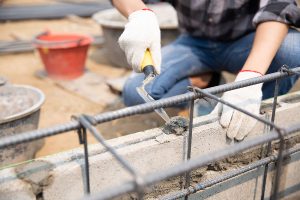Seasons change and a big construction project will definitely see the transition. It can’t be avoided that you will experience working in the rain. And when the wet season comes, firms are kind of hesitant to do cement works because it might not cure and might not solidify.
But won’t it?
Civil engineers and his team should be prepared to fight all kinds of seasonal fluctuations whether it is extremely cold or inclement rains. In our most recent blog, we discussed how weather fluctuations can bring different kinds of impediments and how you can effectively manage these delays using reliable construction management software like Pro Crew Schedule. And you know very well by now how delays caused by weather can lead to over cost. For that, you need to have alternate plans. And when the rainy days are so long, then that alternative plan is to have no other choice but to push through with necessary phases like pouring concrete.
And it’s possible.
With a few smart tricks, you can actually do concreting even during the rainy season.
Concreting During the Rainy Season
Here’s a fact: concrete mix gets severely affected by rains but that is only when it has yet to reach its initial setting time which is usually 30 minutes. But when the concrete is already between its initial setting time and final setting time, the rain merely affects the appearance of the concrete leaving patch marks all around.
Now, if the rain volume is too high, the upper layer of the concrete mix in the upper layer may get disturbed. But after the concrete has reached the final setting time which is 10 hours, the rain now becomes a source for the curing process.
And here are some other pointers to help you do successful concrete pouring during the rainy season:
1.Control the water you use in the mixture
During the rainy season, there is increased humidity in the air and so, your raw materials (aggregate and sand) will be wetter. To control the wetness, you should be particular about the amount of water that you will still need to add to the mixture. Excess water should be compensated to stay within the Design mix’s limit. You can also use admixtures to reduce the water-cement ratio but you will need to consult with your client first if he agrees with the mixture.
2.Waterproof your admixtures
The use of hydrophilic crystalline admixtures when laying the concrete provides it some resistance to water infiltration under hydrostatic pressure. Now, the admixture reacts with water and cement particles to form calcium silicate crystals that block both the pores and microcracks in the concrete. This is how the passage of water is prevented. The reaction lasts for the entire life of concrete and seals both initial shrinkage cracks and the cracks that occur over time.
3.Choose the right timing to pour the concrete
Even though it’s the rainy season, it won’t rain every day. When you are preparing to pour concrete, you need to make sure that the weather conditions are not overly wet or windy. Besides, you will only need to have 12 hours of dry weather before you pour the concrete. Of course, it will be difficult to tell but there are accurate weather forecast apps and websites that can look into a week’s detailed weather condition. You may not see this during the design and planning stage and this is why we always advise preparing for worse conditions. With the use of a construction project management software like Pro Crew Schedule, changing schedules and letting all members of the team should be easy.
4.Combat heavy winds with nets
Strong and resilient shuttering should be ensured before pouring concrete. Heavy winds may cause bleeding which may lead to shrinkage cracks. The use of construction nets can at least minimize the effects of the wind so you can consider using this option when it’s time to pour concrete.
5.Plan transportation routes of RMC Trucks
The rain always causes traffic jams and congestion. This is why during the planning stage, you should also include the best accessible routes for RMC trucks or concrete mixer trucks. As most of the RMC trucks have an open top, any delay in the delivery may allow rainwater into the chamber. This will spoil the concrete mixture and will be useless.
6.Prepare covers ahead
It’s common sense to prepare plastic tarpaulins and rainproof covers in advance to keep the area dry from rain. As we mentioned earlier, you need the area to be dry for 12 hours so to be sure (and we’re imagining that there are no walls yet to stop splashes of rain from entering the structure) you have to cover the space to compact and finish the concrete surface. If possible cover the heaps of aggregate and sand too.
7.Make instant repairs when there are damages
After the rainstorm tames down, it is necessary to assess the possible damages on the concrete’s surface. A simple scratch test can be conducted to compare the relative surface scratch hardness of areas in question to those slab sections that you know are with good quality. If you think that the surface quality of the concrete has been compromised, then prepare to do minor repairs and they should be done immediately after the rain stops. Singular repairs can be made using some of the same concrete or spraying cement slurry on the surface.
However, if you detect a lot of small areas of a thin slab are damaged, it is advisable to just remove and replace the complete sections. Meanwhile, if the damage occurred on a large isolated area in a thick slab with damage, it is recommended to put a thin application of cement slurry after the damaged concrete is removed.
Conclusion
Damages caused by the rain to your construction project can be big and costly. The risks of delays are also there. The key to mitigating these damages to the concrete lies in proper preparation, accurate predictions, and good timing. Prepare and plan with your construction project management software to handle the operations well during the rainy season.
Also, remember to have a protective enclosure built around the work site using nets and plastic tarpaulins. Finally, when you are already in the process of pouring and the rain suddenly drops, it’s best to wait and let the rain pass before you move the surface water off the concrete surface and complete the finishing.






1 thought on “7 Tips for Successful Concreting During the Rainy Season”
Attractive portion of content. I just stumbled upon your site
and in accession capital to assert that I acquire actually loved account your weblog
posts. Any way I will be subscribing for your feeds or even I achievement
you get right of entry to persistently rapidly.